Features of wood-fired swimming pool stoves
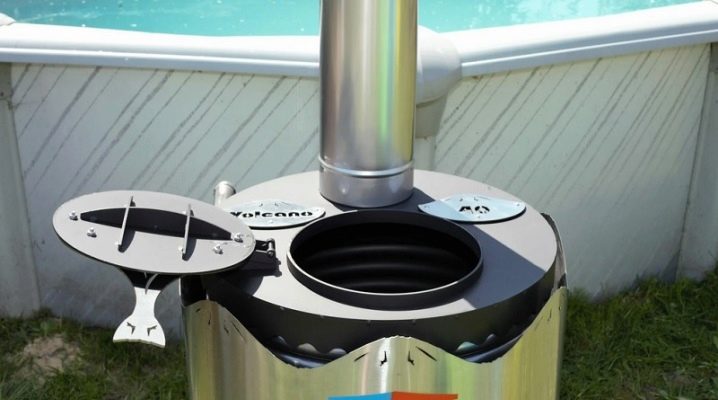
In the territories of summer cottages and suburban areas, frame pools are often installed. In terms of convenience and practicality, they are many times superior to inflatable products and, at the same time, are much cheaper than models made of concrete or brick.
The ever-growing demand for such designs has led to the need to find ways to heat water. The most efficient and at the same time economical technology is the use of wood-burning stoves.
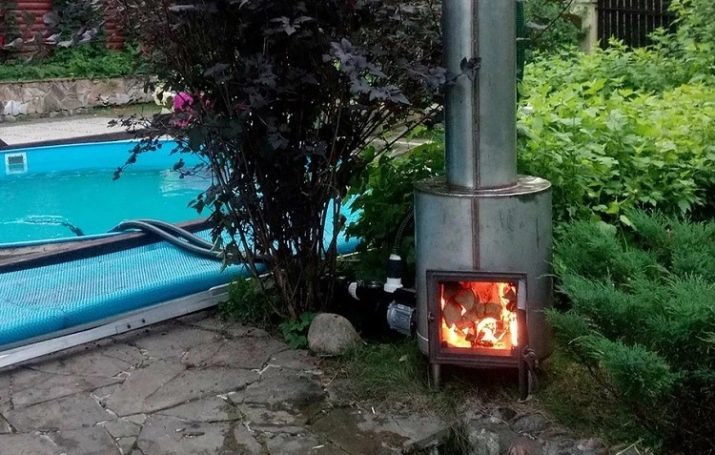
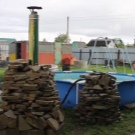
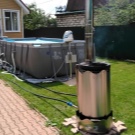


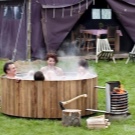
general description
A device for heating an outdoor pool using firewood can be freely purchased in any stores: both offline and via the Internet. Moreover, the principle of operation of such heaters is very simple and straightforward. The wood-fired boiler is a primitive construction, its main functional blocks are the firebox and the coil.
- The firebox is the outer shell of the device. It is made of high quality hardened steel alloy, which does not lose its strength and does not deform under the influence of high temperatures. Depending on the model, boilers can be of different sizes and configurations.
- The coil is a steel tube with thick walls. It is located inside the furnace structure and is supplied to the pump.
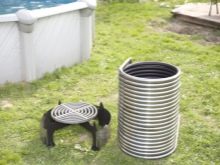
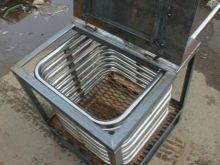

The water in the pool is heated according to the following scheme.
- To begin with, the wood heater is connected to the circulation pump. Then the pump is activated and water gradually begins to flow into the coil.
- Next, firewood is thrown into the boiler, they must be small and always dry. The fuel is ignited, as it burns out under the influence of the flame, the water in the coil quickly heats up.
- Another pump sends the heated liquid back to the pool bowl. In this case, the circulation of water is carried out quickly enough: so much that the water heats up well, but at the same time it does not have time to go into the boiling stage.
There are many types of wood-fired boilers for outdoor pools on sale these days. They are both large and very compact. The largest ones have a height of about 1 m, and the built-in coil in them can weigh up to 100 kg. The power of such installations often reaches 35 kW. Depending on the modification, the number of turns in the coil can also vary: from 4 to 20-25.
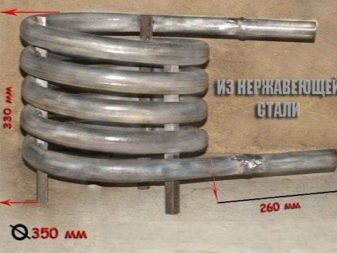
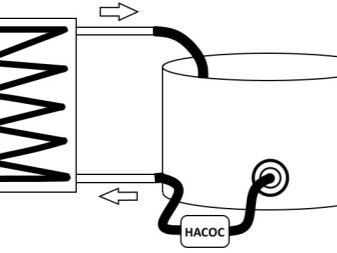
Wood-burning stoves have their own significant advantages.
- They are unpretentious in operation: their technical design allows the processing of large volumes of water and does not require specialized maintenance. Most often, the owners do not even have to make repairs. Such units serve faithfully for several decades and fail in the rarest of cases.
- The use of wood-burning boilers allows you to maintain the required temperature in the pool for a long time and, if necessary, adjust the heating parameters.
- The wood-fired boiler functions autonomously, it does not require connection to the water supply and to the electrical network. If desired, you can move it to any convenient place.
- Another important advantage of this type of heating is the possibility of its own production in a home workshop.
Tip: instead of firewood, you can take coals. In this case, they will burn even longer.
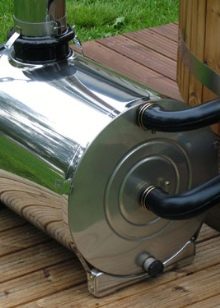

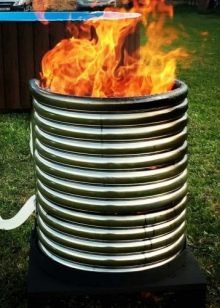
However, there are also disadvantages.
- Pool owners need to have an adequate supply of firewood, with priority given to dry material.When using damp wood, condensation forms in the chimney, and this causes rust on the metal elements.
- From time to time, you will have to remove by-products formed after combustion: soot, ash.
- The combustion process must be kept under vigilant control. It is important to keep the flame alive and not let it go out.
- The process of supplying fuel to the boiler is not automated; it must be done manually.
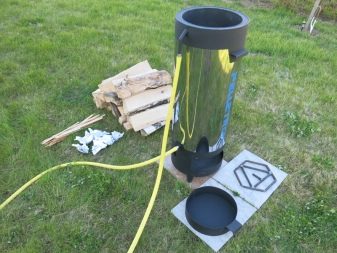

Popular models
Nowadays, shops have a wide selection of a wide variety of different models of wood-burning stoves for heating water in an outdoor pool. They are produced by many enterprises that directly produce swimming pools. The most widespread are the products of the Buderus company: this brand from Germany has been producing heating devices for many years.
As for furnaces for heating water in artificial reservoirs, the models S111-32D, S111-45D, as well as S171-22W and S17-50W are in the greatest demand. Also in demand are Nexus and Pelletron fireboxes with a water circuit.
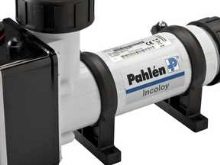

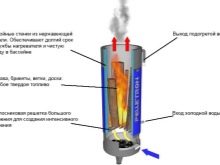
Selection Tips
When choosing a wood-burning boiler for water in an outdoor pond, you need to take into account many factors. Not only the efficiency of heating largely depends on them, but also the safety of users who are nearby. Therefore, it is very important to consider:
- dimensions and volume of equipment;
- the metal from which the structure is made;
- the power of the pump connected to the furnace;
- the amount of water that the device will have to heat.



Of course, the manufacturer and the price of the offered products play an important role. Experienced experts recommend giving preference to solid fuel stoves of well-known brands that provide high quality, long service life, reliability and safety of their stoves.
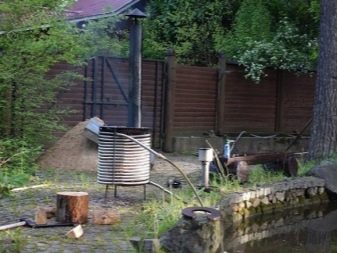

If we are talking about heating all-season pools with a large capacity, then roomy brick fireboxes with a built-in heat exchanger will best cope with maintaining the required temperature in them. It is optimal that they be equipped with long-burning boilers or pyrolysis boilers with a shaft-type design. The advantage of such cats is the ability to maintain the same heating level for a long time.
Such boilers have a long period of independent operation without the need for additional fuel loading. In addition, they allow heating by means of indirect heating.
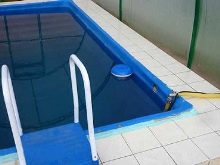
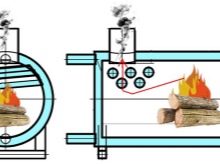
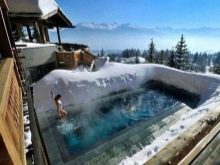
The disadvantages of such a system are:
- quite high price;
- laborious and complex technical piping;
- cumbersomeness, entailing the need to allocate a large area for the firebox on the site.
To maintain the correct temperature in indoor seasonal swimming pools, the main requirement is increased capacity. The optimal indicator is calculated taking into account the data on the volume of the pool, the difference in heating of the liquid, as well as heat losses. Let us explain with an example: in order to increase the temperature of 1 liter of water by 1 degree within 1 hour, 0.001 kW of energy is required.
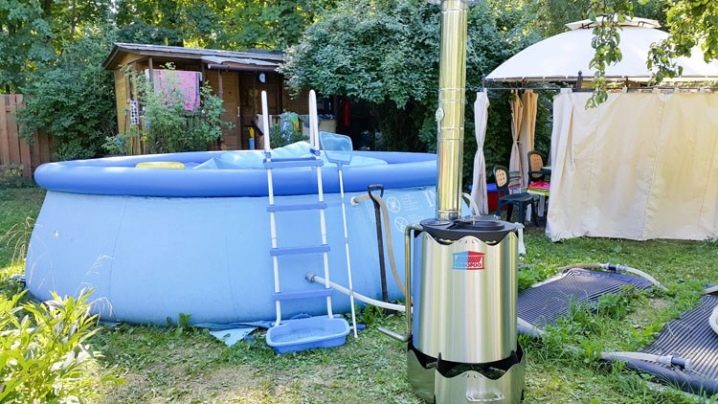
Accordingly, it is possible to warm up 1 thousand liters during the same time using 1 kW of power. Taking into account heat losses, this indicator must be multiplied by correcting by 1.2-1.3. Thus, a 25 kW boiler in a quarter of an hour will warm up one cubic meter of water by 1 degree. Based on this, you need to choose the optimal equipment.
If you plan to use a compact pool outdoors at low temperatures, you should also pay attention to the power characteristics of the stove and its mobility. The compact and lightweight unit will be a nice addition to the high performance.
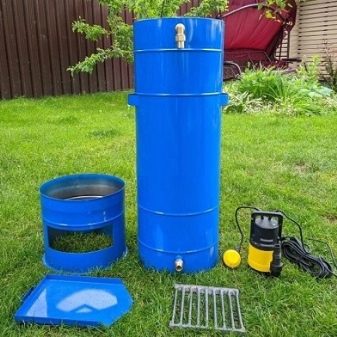
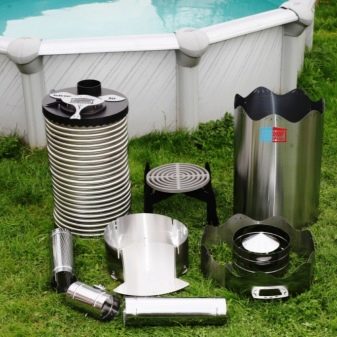
How to build it yourself?
The main advantage of store-bought wood-burning boilers is that they have a stylish appearance, which means they harmoniously fit into the landscape.If this criterion is not of fundamental importance, you can always try to make a wood-burning boiler for heating frame pools with your own hands.
Let us dwell in more detail on the method of making a firebox from an unnecessary water-heating boiler. As a rule, such containers have rather thick walls, so they can be used to build reliable stoves that do not burn out for a long time.

Tools and materials
Diagrams and drawings are not required when using this method of manufacturing a furnace. And you don't need a lot of materials for work. You will need a chimney, as well as scrap metal for making legs, handles, and other parts.
So, for work you need to prepare:
- a failed water heater, a gas one will do;
- a fragment of a steel pipe for the manufacture of a chimney;
- any iron plate: you will make a valve from it;
- a small piece of sheet steel or an unnecessary gas cartridge for the door;
- loops;
- small bolts with nuts and washers;
- fiberglass or other fabric with similar properties for the design of the gasket;
- tin can.
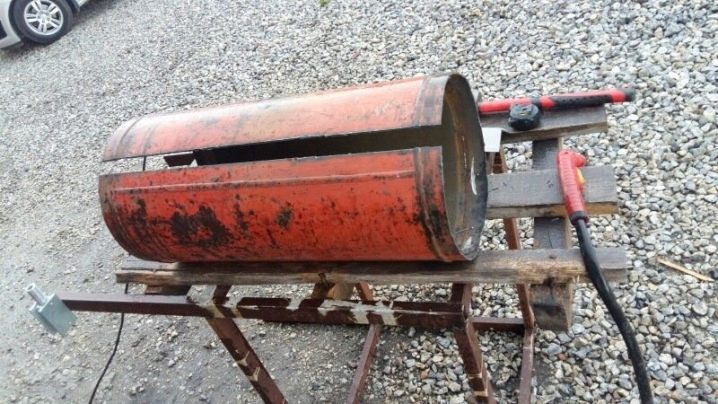
Manufacturing technology
Let's see how to properly make a homemade heating stove.
Boiler preparation
For making a homemade boiler, any old boiler will do, even one with holes in it will do. The main thing is that the walls remain relatively thick and do not burn out under the influence of high temperatures. As for the dimensions, here the choice is individual, it is at the discretion of the owner of the pool. As practice shows, it is most convenient to work with a capacity of 150-200 liters. Typically, hot water boilers are well insulated to maximize heat retention.
This insulation layer should be cleaned off: for this you can take a grinder, a knife or any other available tools. In addition, the metal part is likely to be painted or covered with glue in some places: such residues must also be removed completely. Take a grinder and clean the future firebox to an even shine.
Advice: if the paintwork is poorly peeled off, then you can first burn it thoroughly with a soldering iron or over a fire. At the same stage, everything that can be unscrewed from the water boiler should be unscrewed: pipes, fittings, as well as taps and other elements. If they don't twist off, cut them off with a grinder.
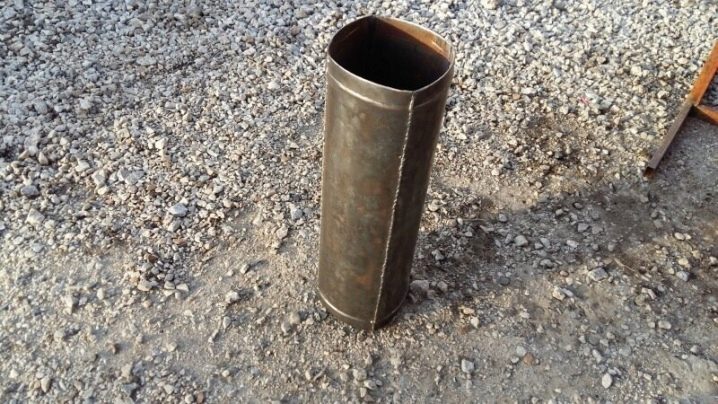
Door decoration
Decide on a place under the door through which you will load firewood. Calculate the required dimensions and draw an outline on the wall of the boiler using a marker. After that, you can cut the door hole. It is best to take a grinder for this.
Keep in mind that the cut must be made in such a way that the abrasive wheel moves in the opposite direction from the direction in which you are cutting. With this approach, the cut-off wheels of the tool will last much longer.
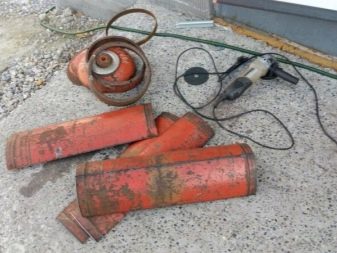
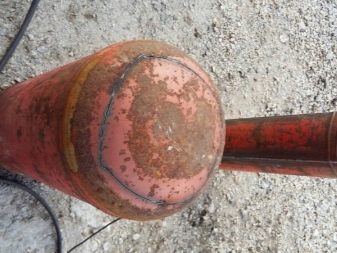
Forming a hole for a chimney
A hole must be made in the boiler, taking into account the section of the chimney that you have available. How to weld the pipe is up to you. The most important thing is that the junction is as tight as possible, otherwise smoke will go through the room. You can form a hole slightly wider than the pipe size and then insert a workpiece into it. Or, on the contrary, you can make it a little narrower, and then weld the steel pipe end-to-end. Ideally, you should have a strong and tight seam.
Tip: you can make a hole of the desired shape with a reciprocating saw. To do this, first, a small perforation is drilled under the knife, after which the entire hole is cut out.

Preparing a blower hole
The blower is an indispensable structural element of any furnace. Thanks to it, air is supplied and thereby uniform combustion of the fuel is ensured. Usually the blower looks like an elongated tube with holes and runs all over the stove.
A hole for it is cut out according to the same scheme according to which the perforation for the chimney was prepared. First, a small hole is made, and then the main one is prepared using a reciprocating saw.
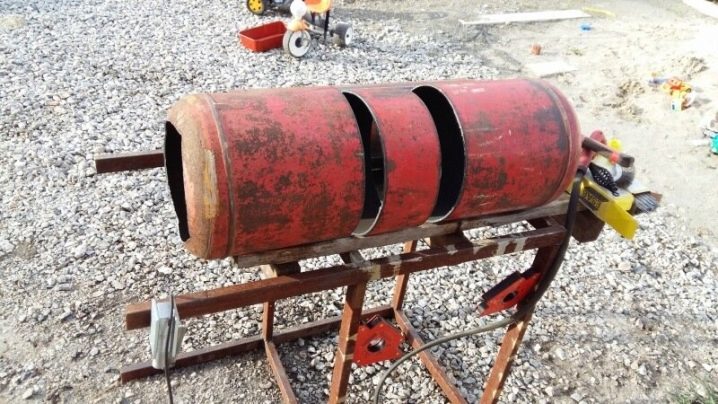
Pipe making
The next step involves making a pipe for the blower. This will allow the wood to be burned in such a way as to maximize the release of heat energy. To do this, take a pipe, the size of which corresponds to the length of the boiler or slightly less than it, then drill holes in it. Their location is not of fundamental importance, but in order to ensure an even distribution of air, it is better to place them at an equal distance from each other. At the very beginning, form a slot for a bolt and nut: there will be a damper with which you will control the air flow and monitor the rate of fuel combustion. For the manufacture of the door, you can take the part that you cut out in the first stages. But if you put it just like that, it will be a little small, and the smoke from the firebox will begin to seep out.
To make the surface wider, you need to take a helium cylinder, cut out a square from it, the area of which exceeds the size of the door opening. Do not forget to remove the paintwork, otherwise, when heated, it will begin to burn intensely and give off a pungent chemical odor. Build the simplest grates for your firebox, they can be welded from thin fittings. After that, weld the pipe, as well as the blower pipe, into place. The stove is ready, you just need to install it on a fireproof platform or weld the legs, since the metal is very hot. Now you can safely use your new equipment. Open the door carefully, put the wood in and cover. Take a match or a lighter and light the fuel through the hole located in the boiler below. When the firewood is well heated, this hole must be blocked. For this, a tin can, a bolt, or even a nail will do.
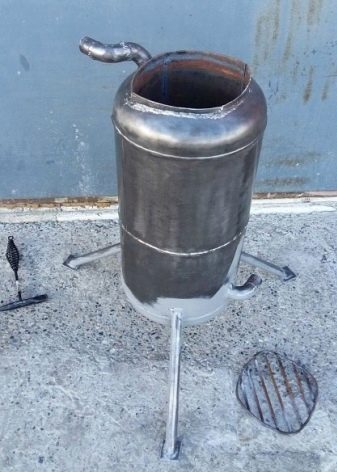
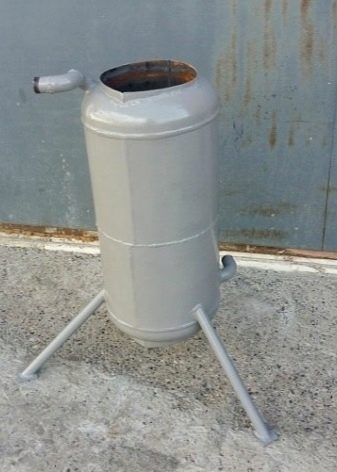
Operating tips
To heat the water for the pool in the country and at the same time not harm the property and life of users, you should adhere to safety rules.
- Keep in mind that any heaters must only be used in conjunction with a running pump. If the pumping mechanism turns off, pour running water into the fire in small portions until it dies out completely. This will avoid unwanted consequences.
- If the flame is not extinguished in time, then the water remaining in the spiral coil will continue to heat up and reach a boil, after which it will begin to throw portions of boiling water into the container. This often leads to deterioration of the material from which it is made, and can also cause burns for people bathing in the water.
- The boiler should be installed at least 5 m away from any structure, especially one made of wood.
- It is important to make sure that there are no flammable items or liquids within 1.5 m of the heater.
- The area around the firebox within a radius of about 10 m must be cleared of any grass and plant residues.
- The boiler must not be installed under tree branches.
- The pool stove must not be left unattended, especially during the active combustion phase.
In the event that it becomes necessary to leave, you should seek the help of an adult who can look after the equipment until you return.
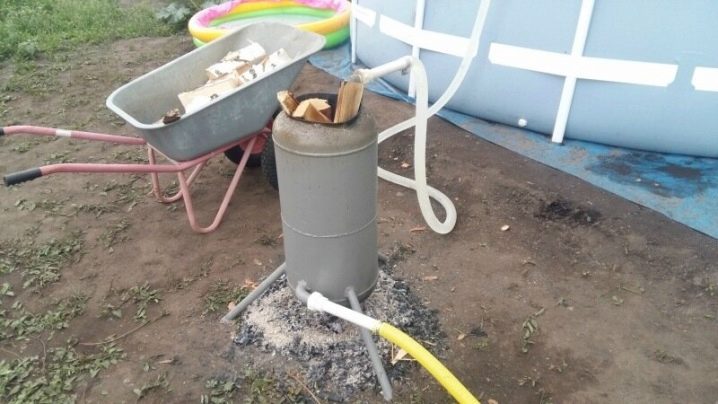



































































The comment was sent successfully.